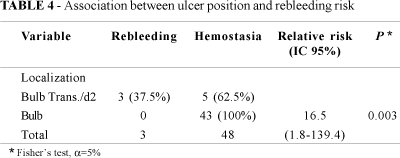Background - Bleeding ulcers are a major problem in public health and represent approximately half of all the cases of upper gastrointestinal hemorrhage in the United States. This study aims to determine the prognostic value of factors such as clinical history, laboratory and endoscopic findings in the occurrence of new episodes of bleeding in patients who have upper gastrointestinal hemorrhage caused by gastric or duodenal peptic ulcer. Methods - A cohort study with 94 patients was designed to investigate prognostic factors to the occurrence of new episodes of bleeding. Results - From the 94 patients studied, 88 did not present a new bleeding episode in the 7 days following hospital admission. The incidence of rebleeding was significantly higher in those patients with hemoglobin <6 g/dL at the admission (P = 0.03, RR = 6.2). The localization of the ulcers in bulb was positively associated to rebleeding (P = 0.003).The rebleeding group needed a greater number of units transfunded (P = 0.03) and the time of hospitalization was longer than the time of the hemostasia group (P = 0.0349). Conclusions - The identification of patients with risk of death by bleeding peptic ulcer remains as a challenge, once few factors are capable of predicting the severity of the evolution. The identification of such factors will allow the choice of the better therapeutic conduct improving the diagnosis and decreasing the rate of rebleeding and the mortality.
Peptic ulcer hemorrhage; Gastrointestinal hemorrhage; Risk factors




